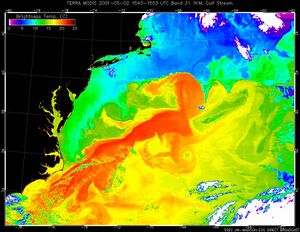Flow tracer


A flow tracer is any fluid property used to track the flow velocity (i.e., flow magnitude and direction) and circulation patterns. Tracers can be chemical properties, such as radioactive material, or chemical compounds, physical properties, such as density, temperature, salinity, or dyes, and can be natural or artificially induced. Flow tracers are used in many fields, such as physics, hydrology, limnology, oceanography, environmental studies and atmospheric studies.
Conservative tracers remain constant following fluid parcels, whereas reactive tracers (such as compounds undergoing a mutual chemical reaction) grow or decay with time. Active tracers dynamically alter the flow of the fluid by changing fluid properties which appear in the equation of motion such as density or viscosity, while passive tracers have no influence on flow.[1]
Uses in oceanography
Ocean tracers are used to deduce small scale flow patterns, large-scale ocean circulation, water mass formation and changes, "dating" of water masses, and carbon dioxide storage and uptake.[2][3]
Temperature, salinity, density, and other conservative tracers are often used to track currents, circulation and water mass mixing.[4] An interesting example was when 28,000 plastic ducks fell over board from a container ship in the middle of the Pacific Ocean. The following twelve years oceanographers recorded where the ducks washed ashore, some thousands of miles from the spill site, and this data was used to calibrate and verify the circulation patterns of the North Pacific Gyre.[5]
Transient tracers change over time, such as radioactive material (Tritium and Cesium-137) and chemical concentrations (CFCs and SF6), which are used to date water masses and can also track mixing. In the mid-1900s, Nuclear weapons testing and chemical production released tons of compounds that are not naturally found in the environment.[citation needed] While extremely unfortunate, scientists were able to use the concentrations of anthropogenic compounds and half-lives of radioactive material to determine how old a water body is. The Fukushima nuclear disaster was really well studied by oceanographers, who tracked the radioactive material spread throughout the Pacific Ocean, and used that to better understand ocean currents and mixing patterns.[6][7]
Biological tracers can also be used to track water masses in the ocean. Phytoplankton blooms can be seen by satellites and move with the changing currents. They can be used as a "check point" to see how well water masses are mixing. Subtropical water is often warm, which is ideal for phytoplankton, but nutrient poor, which inhibits their growth, while subpolar water is cold and nutrient rich. When these two types of water masses mix, such as the Kuroshio Current in the north Pacific, it often causes huge phytoplankton blooms, because they now how conditions they need to grow—warm temperatures and high nutrients. Vertical mixing and eddy formation can also cause phytoplankton blooms, and these blooms are tracked by satellites to observe current patterns and mixing.[8][9][10]
See also
References
- ↑ Stutter, MI; Deeks, LK; Billet, MF (2005). "Transport of conservative and reactive tracers through a naturally structured upland podzol field lysimeter.". Journal of Hydrology 300 (1–4): 1–19. doi:10.1016/j.jhydrol.2004.04.026.
- ↑ Bigg, GR; Killworth, PD (1988). "Conservative tracers and the ocean circulation.". Phil. Trans. R. Soc. Lond. 325 (1583): 177–189. doi:10.1098/rsta.1988.0050. Bibcode: 1988RSPTA.325..177B.
- ↑ "Ocean Tracer". 13 May 2014. https://www.pmel.noaa.gov/project/ocean-tracer.
- ↑ Holland, William R. (1971). "Ocean tracer distributions: Part I. A preliminary numerical experiment" (in en). Tellus 23 (4–5): 371–392. doi:10.3402/tellusa.v23i4-5.10517. ISSN 0040-2826.
- ↑ Ebbesmeyer, Curtis. "Beachcombing Science from Bath Toys". http://beachcombersalert.org/RubberDuckies.html.
- ↑ Behrens, E; Schwarzkopf, FU; Lubbecke, JF; Boning, CW (2012). "Model simulations on the long-term dispersal of 137Cs released into the Pacific Ocean off Fukushima.". Environmental Research Letters 7 (3): 034004. doi:10.1088/1748-9326/7/3/034004. Bibcode: 2012ERL.....7c4004B.
- ↑ Jenkins, WJ; Schwarzkopf (2006). "Tracers of Ocean Mixing.". The Oceans and Marine Geochemistry. 6 (223).
- ↑ Clayton, S; Lin, YC; Follows, MJ; Worden, AZ (2017). "Co-existence of distinct Ostreococcus ecotypes at an oceanic front.". Limnology and Oceanography 62 (1): 75–88. doi:10.1002/lno.10373. Bibcode: 2017LimOc..62...75C.
- ↑ Mahadevan, A (2016). "The impact of submesoscale physics on primary productivity of plankton.". Annual Review of Marine Science 8: 161–184. doi:10.1146/annurev-marine-010814-015912. PMID 26394203. Bibcode: 2016ARMS....8..161M.
- ↑ "Spring plankton bloom hitches ride to sea's depths on ocean eddies". March 2015. https://www.nsf.gov/news/news_summ.jsp?cntn_id=134551&org=NSF&from=news.
- R. E. Davis (1991). "Lagrangian Ocean Studies". Annual Review of Fluid Mechanics 23: 43–64. doi:10.1146/annurev.fl.23.010191.000355. Bibcode: 1991AnRFM..23...43D.
External links
- ctraj Library of advection codes, including passive tracer modelling.
 |

